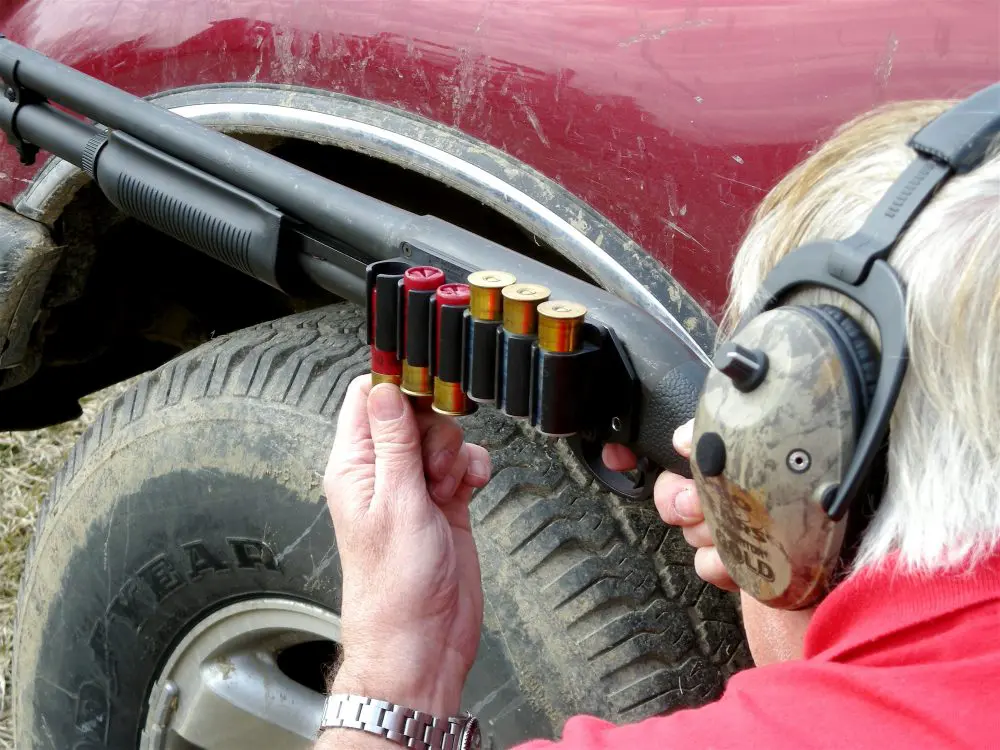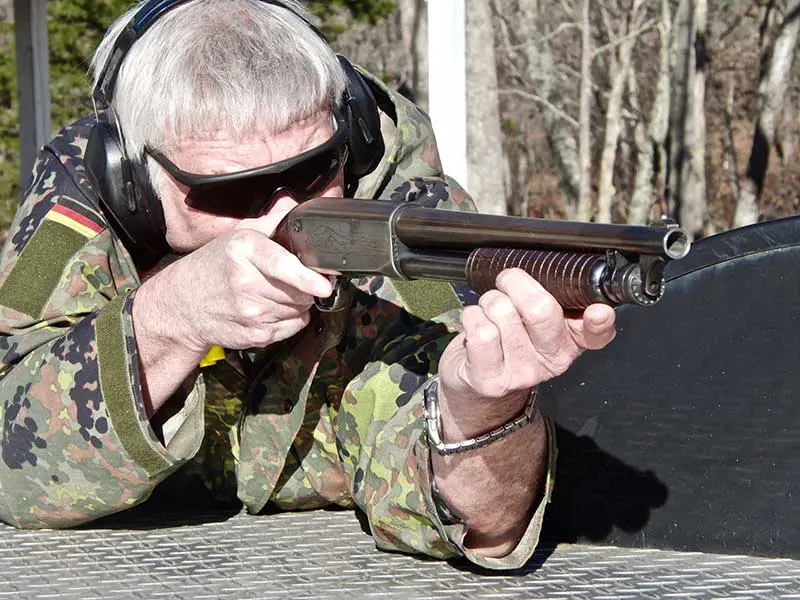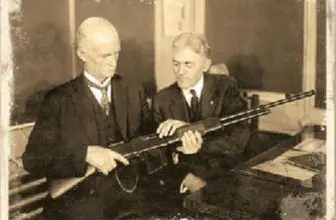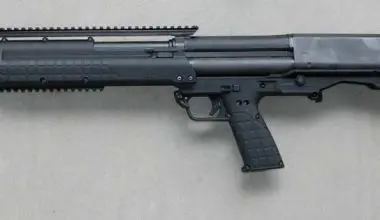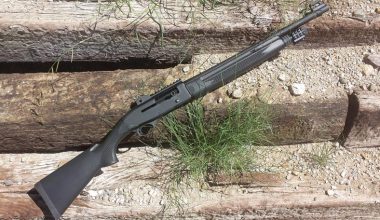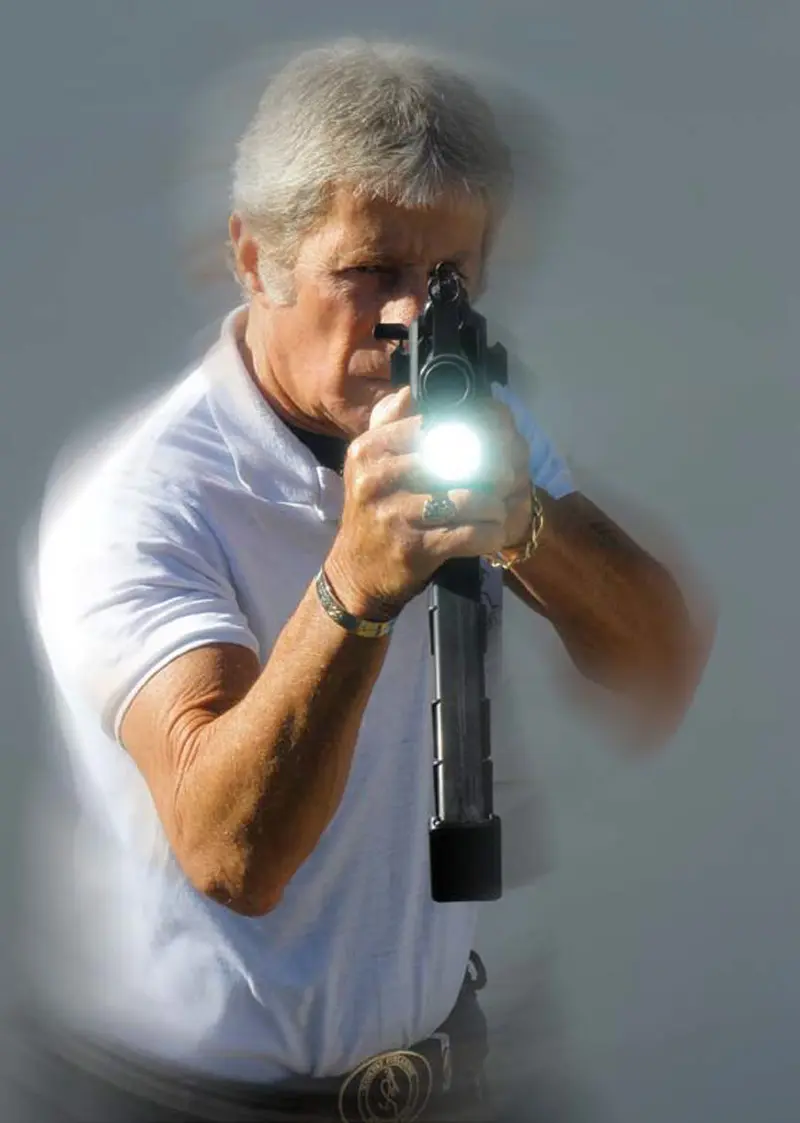
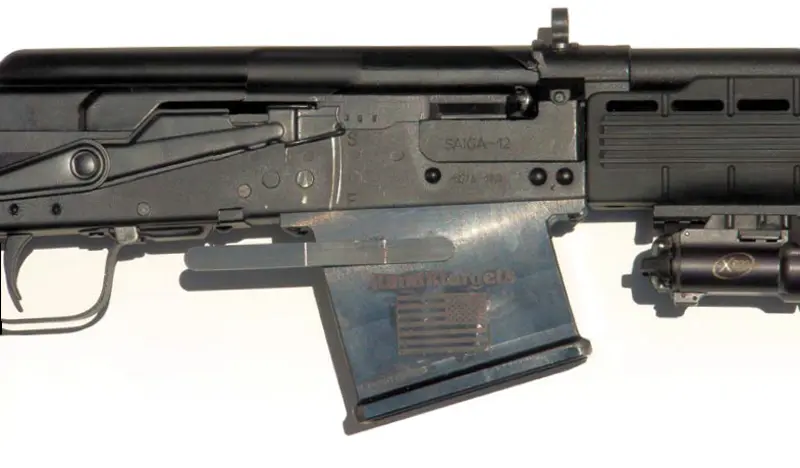
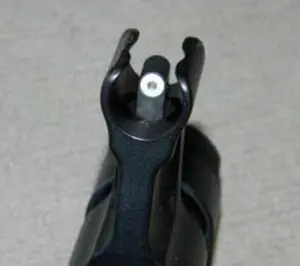
Detractors lean toward the concept of “Anything you can do in battle with your shotgun, I can do better with my carbine,” while proponents argue the power and variety of ammunition merits. As with all other puerile “mine is better than yours” firearms arguments, it’s as stupid as trying to figure out if a tortoise without a shell is naked or homeless.
The crux of the matter is to consider what weaponry will best serve your potential situational battlefield, assuming that you are not being issued only one all-purpose shoulder-fired weapon—because there is no one allpurpose weapon. It just doesn’t exist.
Table of Contents
WHAT WOULD YOU CHOOSE?
Logically, military frontline cannonfodder is/are usually issued the rifle in one configuration—such as the M4 carbine—but snipers are issued a differently configured and calibered rifle. Many trench and building-clearing operators prefer shotguns, but both are supported by cannons and heavy machine guns. But excepting military and some law enforcement personnel, the rhetorical question is what—as a lonewolf urbanite—would you choose as a defensive weapon for the bump-in-thenight situation, be it a home invasion or an urban riot?
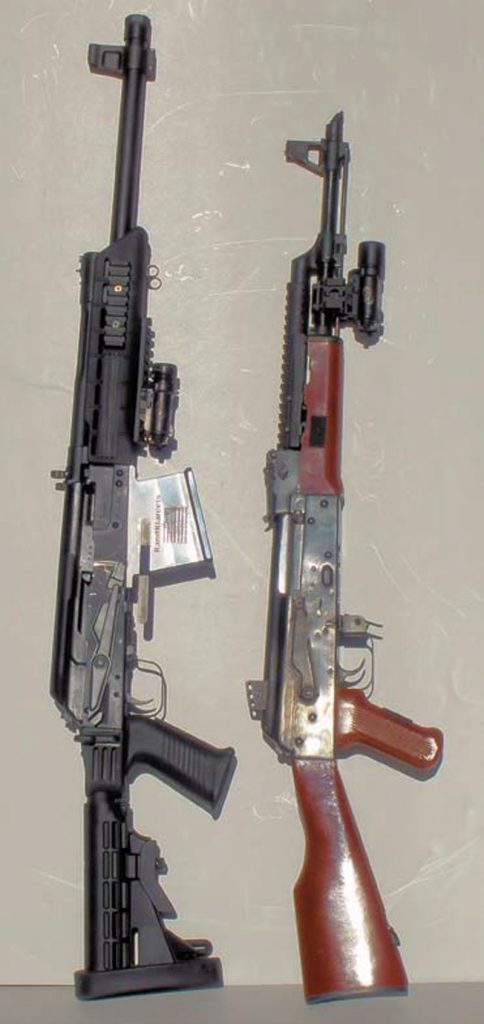
This scribe happens to like shotguns for short-duration conflicts (several seconds to several days). Why? Because I had a bad childhood, am becoming meaner and more cantankerous day by day, and have yet to meet anybody who could absorb well-placed 500-grain bullets and keep on trucking, that’s why. But essentially, yours truly is looking for a powerful tool for dealing with the ubiquitous six-foot to hundredyard anti-personnel problem. And for that, the shotgun is deadly.
So if you decide on the gauge for defensive anti-personnel use, which one do you choose? As mentioned above, there is no all-encompassing firearm—and the shotgun is no exception. Limitations are overall weight and individual ability to carry a plethora of ammunition (hence the short-duration conflict period limiter stated above). On the other hand, if successful, you can always hijack your downed enemy’s weapon and continue from there….
The primary decision hinges on action type, one of the big deciders vis-àvis potential reliability problems. This often leads operators to select a slideaction shotgun, but there are extremely reliable semi-autos out there such as the Benelli M4, among others.
A second decider might be in-thegun ammunition capacity—until now, that is. As of 2010, this latter problem has been alleviated primarily by two shotguns: the pump-action Kel-Tec KSG and the semi-automatic Saiga-12. (The KSG holds a total of 15 rounds. The Saiga-12 will accept five-, eight-, 10-, 12- or 20-round box magazines.)
AUTHOR’S CHOICE
For specific personal reasons, I favor the Saiga, and these follow herewith:
Despite ultra-reliability from the Kel-Tec during testing, the weapon— like its South African forebear, the NeoStead—proved to be too “mindbending” for an operator used to 45 years with “conventional” pump guns. (Specifically, the location of the operational buttons and switches.) Needless to say, this was an operator problem, and not to be laid at the feet of the gun itself.
Another aspect to consider is that if the gun is drained of ammunition, you’re down to the “usual” reloading of one round at a time, including tube magazine selector switch manipulation. The Saiga requires a mere box magazine reload to top up. Maybe a moot point with a 15-round shotgun, but a big consideration in mid-fight— at least in this writer’s mind. But more on this “mere magazine load” later….
This is not a comparison test of the two guns, except to say—apart from the above comments—that the Kel- Tec requires no gunsmithing out of the box, but the Saiga-12 does. (At least, in this author’s opinion, to be a true “fighting shotgun.”) Also, because of its Russian manufacture, the Saiga has to have enough American-made component parts to comply with BATFE “922r” requirements.
And now, finally, on to the gun itself.
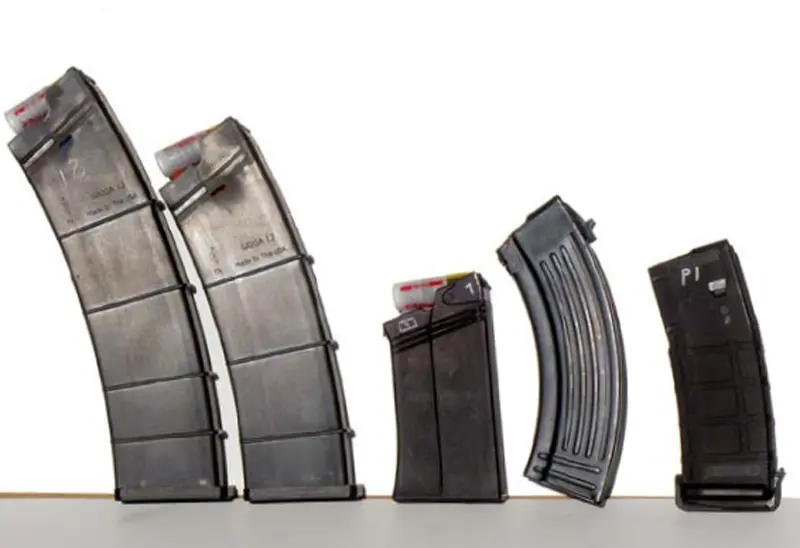
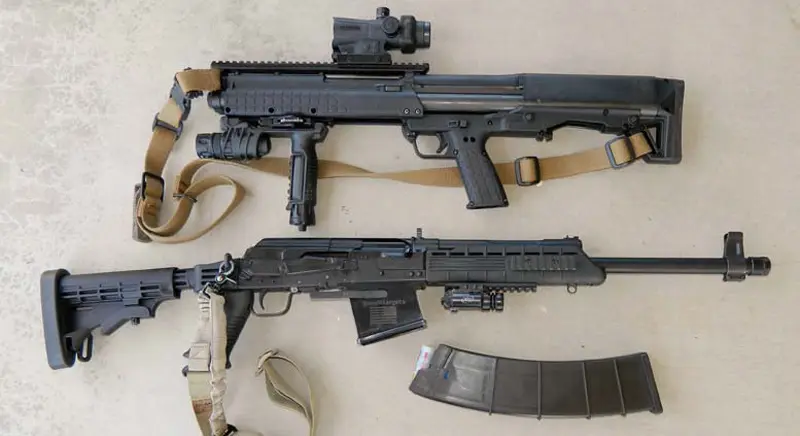
SAIGA SPECS
Manufactured in 12 and 20 gauge, visually the weapon is based on the tried-and-true Kalashnikov system, which is almost synonymous with reliability. Dirty, dry, and abused, it works. Despite some reports of malfunctions, the shotgun pictured has performed flawlessly with all brands of 2 3/4-inch cartridges, from light-load birdshot to heavy-duty slugs.
Probably contributory to its reliability is a two-position gas bleed-off plug and the personal exclusive use of SGM Tactical magazines, in both 10- and 12-round box configuration. The weapon is supplied with a fiveround box magazine or eight-round magazine for Russian military and law enforcement personnel. (The latter, however, is compatible only with a different-receivered Saiga issued to the Russians.)
The magazines themselves are the size of a large metropolitan phone book, and spares are probably best carried on a chest or SAS-style thigh rig. (The 12-rounders measure 13 inches from lips to base plate.) The bolt has a manually operated hold-open device, but does not lock to the rear when livefiring down to empty, which leads to the aforementioned “mere magazine load.”
There’s an expression for loading a fresh magazine into a Saiga when the bolt is closed. The expression is colloquially known as a pain in the rear end, and would suck in a fight if using the factory stock system.
With the bolt locked open, magazine insertion is the same as the simple “rock and lock” technique used on a Kalashnikov or Ruger Mini-14 rifle. However, because the front of the top 12-gauge cartridge protrudes at an angle way above the Saiga magazine lips, the operator has only two loading choices: (1) hold open the bolt (or lock it open prior to insertion), or (2) carefully insert and lock in the magazine at a perfect angle—and it has to be perfect or the top cartridge in the magazine pushes against the underside of the closed bolt and the magazine won’t lock in. There are alternate techniques, but they still suck and are too timeconsuming unless you have hard cover or three hands.
ACCESSORIZING
Here’s where the accessorizing becomes almost mandatory. Enter the magazine well manufactured by Robert Wright of R&R Target. It does require non-reversible machining of the receiver, but is a simple process for any competent machinist (mine was done by the Robar Company) and results in a “normal” box magazine insertion technique, such as with an M16 rifle.
The magazine “extension” is well designed and manufactured, though some squared edges were rounded off on the weapon pictured. It also comes with an intentionally overlong magazine release lever, to be shortened later to the operator’s requirements. In addition, the stock magazines require a slight modification to mate with the R&R well, which is available in left- or right-handed versions.
I chose the right-handed version for quick reloads, even though I shoot the weapon left-handed. This puts all the controls—both factory and aftermarket— on the right side of the weapon, allowing for non-firing-hand manipulation of every physical bell, whistle and lever on the weapon, save obviously for the trigger. Since it’s carried on a single-point sling, the gun can be instantly flipped to the right shoulder for “standard” right-handed operation. The weapon is slung with the left side of the gun facing the torso, right or left handed, to negate an accidental release of the magazine by bumping the R&R release lever with body contact.
In addition, an extended manual safety was added to facilitate quicker on/off manipulation for right-handed operation. Since this author happens to have been familiar and ambidextrous with Kalashnikov systems for over 40 years, this was neither necessary nor a criterion—but there’s no harm in having a bonus insurance policy.
For that matter, you could have an ambidextrous cocking handle fitted— several gunsmiths are now offering this service—but I chose to forego this option. (The modification allows bolt manipulation on the left side of the weapon for right-handed shooters.) Thus, a couple of aftermarket accessories and a little machining converted this homeless tortoise into a battleready greyhound.
SIGHTS
Next on the accessory list was a set of sights from Krebs. The factory standard bead and Patridge rear combo were adequate. In fact, they were more than adequate, and proved—from the factory— to have dead-on point of aim/ point of impact at 50 meters. They were, however, a little slow to visually pick up in poor ambient light against a dark background. The Krebs aperture rear and M16-style front were an easy owner-installed pair, with quality and fit re-emphasizing this company’s usual attention to detail and good customer service.
The rear gives the user the option of a medium-sized or large, almost ghost ring-sized aperture. I opted for the latter, which is achieved by the removal of an internal disc and two vertical grub screws, inserted by the manufacturer for this purpose. The sight replaces the original rear by the simple expedient of shoving the old one out of its dovetail and inserting the new, with the replacement sight plane barely higher than the original. This obviously means you don’t have to “hold over”—even at close quarters—because the top of the front sight is only 1 1/2 inches above center boreline. This is the same measurement as the factory receivermounted bead sight—and you’re using a 3/4-inch bullet.
Since the Krebs front sight system emulates the M16 front post installation, I chose to replace the post with one from XS Sight Systems for added “visibility insurance.” An ambidextrous reversible sling mount, retractable stock and forend were added via Cheaper Than Dirt—another company that always seems to supply truly readyto- fit parts with outstanding service.
Reasons to have instant length-ofpull changeability are obvious. The forend was changed from the original because it comes with rails, and I chose not to drill holes in the original and I’m one of those paranoid weirdos who won’t run a long gun without a dedicated white light attached to it (or at least the capability thereof).
PERFECTION
Is this the perfect fighting shotgun? No. We’ve already discussed the firearms unicorn. But at this stage and for this writer, the only downside is the size of spare magazines for this well-balanced, low-recoiling, high-capacity 12 gauge.
Having to switch ammunition types—commonly known as a “Select Slug” drill—with the Saiga entails a magazine speed load and running the bolt. Since I run only slugs for war, this is not a bone of contention for me, but should you choose to pack the ubiquitous mix of buckshot and slugs in your carry arsenal, the magazine switch and bolt-run are no slower than any other shotgun system if the Select Slug process has to be executed. Ergo, the manipulation and magazine selection of a Saiga shotgun could depend on the type(s) of ammunition you carry, and should be considered before it’s needed in a ballistic confrontation.
As with any other physical-force scenario, one hopes never to have to use it. But if I’m forced into it, with “Igor” at my side, I figure I’ll run out of luck or blood long before I run out of ammunition.
